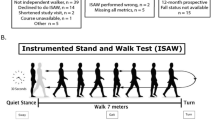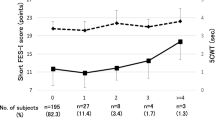Abstract
The aim of this study is to investigate the association between falls and physiological factors primarilly the toe-gap force and the Good Walker’s Index using a path analysis. Three hundred and sixty-two (362) elderly people, over 65 years of age, undertook five types of walking ability and physiological tests, The Toe-gap Force and the Good Walker’s Index, which consists of 10-m walking time, Maximal Step Length (MSL), 40/20 cm step test, and tandem gait. Questions concerning demographic characteristics, instrumental activities of daily living (IADL), subjective well-being, long-term care needs, and characteristics of falls were asked. Ninety participants (24.9%) reported one or more falls within the past year. The results showed that a lower toe-gap force and a lower good-walker’s Index score were significantly associated with falls. Fallers scored worse on Toe-gap force R, 10-m walking time, and Maximal Step strength. The Good Walker’s Index was significantly associated with all test measures. The path analysis model revealed the association between the Good Walker’s Index and falls. Toe-gap force and the Good Walker’s Index can serve as an effective predictive factor for older people who are living independently in the community. This study provided a model of the inter-relationships among physiological factors such as the Good walker’s Index, Toe-gap force and falls, as well as vision and falls.

Similar content being viewed by others
References
WHO. (2007). WHO global report on falls prevention in older age WHO Global report on falls Prevention in older age. Community Health.
Shimada, H., Tiedemann, A., Lord, S. R., et al. (2010). Physical factors underlying the association between lower walking performance and falls in older people: A structural equation model. Archives of Gerontology and Geriatrics, 53(2), 131–134.
Cho, B.-L., Scarpace, D., & Alexander, N. B. (2004). Tests of stepping as indicators of mobility, balance, and fall risk in balance-impaired older adults. Journal of the American Geriatrics Society, 52(7), 1168–1173.
Pijnappels, M., Delbaere, K., Sturnieks, D. L., & Lord, S. R. (2010). The association between choice stepping reaction time and falls in older adults-a path analysis model. Age and Ageing, 39(1), 99–104.
Yogev, G., Jeffrey, M. H., & Giladi, N. (2009). The role of executive function and attention in Gait. Movement disorder, 23(3), 329–472. doi:10.1002/mds.21720.The.
Yamashita, K., Umezawa, J., Nomoto, Y., & Ino, S. (2005). Evaluation of falling risk by toe-gap force on aged. European Medical and Biological Engineering Conference, 2005, 2–5.
Okada, S., Takahashi, R., Takahashi, M., et al. (2004). Good walker’s index jissenn handbook (2nd ed.). Nagano: Physical Education and Medicine Research Foundation.
Skelton, D. A., Kennedy, J., & Rutherford, O. M. (2002). Explosive power and asymmetry in leg muscle function in frequent fallers and non-fallers aged over 65. Age and ageing, 31(2), 119–125. Retrieved from http://www.ncbi.nlm.nih.gov/pubmed/11937474.
Keskin, D., Borman, P., Ersöz, M., Kurtaran, A., Bodur, H., & Akyüz, M. (2008). The risk factors related to falling in elderly females. Geriatric nursing, 29(1), 58–63.
Laessoe, U., Hoeck, H. C., Simonsen, O., Sinkjaer, T., & Voigt, M. (2007). Fall risk in an active elderly population-can it be assessed? Journal of negative results in biomedicine, 6, 2.
Oshio, A. (2010). SPSS, AMOSniyoru sinnri cyousa data kaiseki (13th ed.). Tokyo tosho.
Bentler, P. M., & Bonnet, D. G. (1980). Significance tests and goodness of fit in the analysis of covariance structures. Psychological Bulletin, 88, 588–606.
Browne, M. W., & Cudeck, R. (1993). Alternative ways of assessing model fit. In K. A. Bollen & J. S. Long (Eds.), Testing structural equation models (pp. 132–162). Beverley Hills: Sage.
Yoshida, S. (2007). A global report on falls prevention epidemiology of falls. Aging and Life course, Family and Community Health, WHO.
Mutou, Y. (2008). Tentou Yobou Igaku Hyakka (pp. 24–29). Tokyo: Nihon Iji Shinpou sha.
Kamioka, H., Mutoh, Y., Ohta, M., & Okada, S. (2001). Screening the fall of the community-dwelling elderly by good walker’s Index. Journal of Physical Education and Medicine, 2, 2–7.
Hirai, H., Kondo, K., Toshiyuki, O., & Murata, C. (2009). Examination of risk factors for onset of certification of long-term care insurance in community-dwelling older people: AGES project 3-year follow-up study. Japanese Journal of Public, 56(8), 501–512.
Kai, Y., Murata, S., & Tanaka, S. (2007). Comparison of foot-gripping strength and quadriceps femoris muscle strength of the dominant foot and non-dominant foot. Rigakuryoyou Kagaku, 22(3), 365–368.
Murata, S., Matsuo, N., & Katsuhiko, M. (2008). Evaluation of lateral dominancy of the upper and lower limb. West Kyushu of Rehabilitation Sciences, 1, 11–14.
Lord, S. R., & Dayhew, J. (2001). Visual risk factors for falls in older people. Journal of the American Geriatrics Society, 49(5), 508–515. Retrieved from http://www.ncbi.nlm.nih.gov/pubmed/11380741.
Acknowledgments
This study was funded in part by a Grant-in Aid from the Ministry of the Environment, Japan. We would like to thank the staff of City A, the local government and the preventive care service establishments for their generous assistance in collecting data.
Conflict of interest
The authors declare no conflict of interest.
Author information
Authors and Affiliations
Corresponding author
Rights and permissions
About this article
Cite this article
Hiura, M., Nemoto, H., Nishisaka, K. et al. The Association Between Walking Ability and Falls in Elderly Japanese Living in the Community Using a Path Analysis. J Community Health 37, 957–962 (2012). https://doi.org/10.1007/s10900-011-9531-y
Published:
Issue Date:
DOI: https://doi.org/10.1007/s10900-011-9531-y




